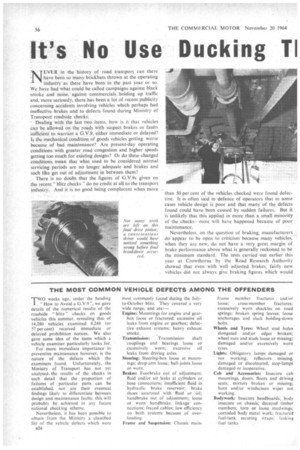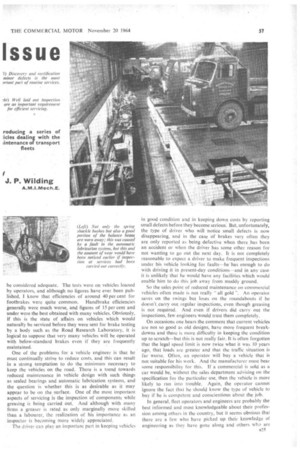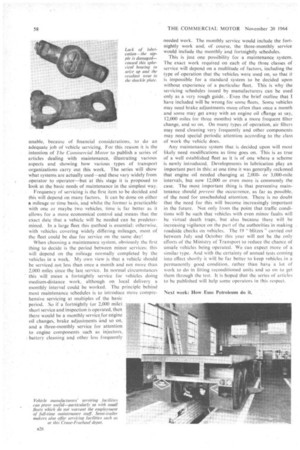s No Use Ducking TI
Page 58

Page 59

Page 60

If you've noticed an error in this article please click here to report it so we can fix it.
Issue
EVER in the history ofroad transport can there have been so many brickbats thrown at the operating industry as there have been in the past year or so. We have had what could be called campaigns against black smoke and noise, against commercials holding up traffic and, more seriously, there has been a lot of recent publicity concerning accidents involving vehicles which perhaps had ineffective brakes and to defects found during Ministry of Transport roadside checks.
Dealing with the last two items, how is it that vehicles Can be allowed on the roads with suspect brakes or faults sUfficient to warrant a G.V.9, 'either immediate or delayed? Is the mechanical condition of goods vehicles getting worse because of bad maintenance? Are present-day operating conditions with greater road congestion and higher speeds getting too much for existing designs? Or do these changed conditions mean that what used to be considered normal servicing periods are no longer adequate and brakes and such like get out of adjustment in between them?
There is no doubt that the figures of G.V.9s given on the recent " blitz checks do no credit at all to the transport industry. And it is no good being complacent when more
than 50 per cent of the vehicles checked were found defective. It is often said in defence of operators that in some cases vehicle design is poor and that many of the defects found could have been caused by sudden failures. But it is unlikely that this applied in more than a small minority of the checks--most will have happened because of poor maintenance.
Nevertheless, on the question of braking, manufacturers do appear to be open to criticism because many vehicles, when they are new, do not have a very great margin of brake performance above what is generally reckoned to be the minimum standard. The tests carried out earlier this year at Crowthorne by the Road Research Authority showed that even with well adjusted brakes, fairly new vehicles did not always give braking Egures which would be considered adequate. The tests were on vehicles loaned by operators, and although no figures have ever been published, I know that efficiencies of around 40 per cent for footbrakes were quite common. Handbrake efficiencies generally were much worse, and figures of 15 per cent and under were the best obtained with many vehicles. Obviously, if this is the state of affairs on vehicles which would naturally be serviced before they were sent for brake testing by a body such. as the Road Research Laboratory, it is logical to suppose that very many vehicles will be operated with below-standard brakes even if they are frequently maintained.
One of the problems for a vehicle engineer is that he must continually strive to reduce costs, and this can result in a strong temptation to do The minimum necessary to keep the vehicles on the road. There is a trend towards reduced maintenance in vehicle design with such things as sealed bearings and automatic lubrication systems, and the question is whether this is as desirable as it may appear to be on the surface.. One of the most important aspects of servicing is the inspection of components while greasing is being carried out. And although with many firms a greaser is rated as only marginally more skilled than. a labourer, the realization of his importance as an inspector is becoming more widely appreciated.
The driver can play an important part in keeping vehicles
in good condition and in keeping down costs by reporting small defects before they become serious: But, unfortunately, the type of driver who will -notice small defects is now disappearing, and in the case Of brakes very often they are only reported as being defective when there has been an accident or when the driver has some other reason for not wanting to go out the next day. It is not completely reasonable to expect a driver to make frequent inspections under his vehicle looking for faults—he has enough to do with driving it in present-day conditions--and in any case it is unlikely that he would have any facilities which would enable him to do this job away from muddy ground.
So the sales point of reduced maintenance on commercial vehicles often made is not really " all gold ". An operator saves on the swings but loses on the roundabouts if he doesn't .carry out regular inspections, even though greasing is not required. And even if drivers did carry out the inspections, few engineers would trust them completely.
On occasions one hears the comment that current vehicles are not so good as old designs, have more frequent breakdowns and there is more difficulty in keeping the condition up to scratch—but this is not really fair, It is often forgotten that the legal speed limit is now twice what it was 10 years ago, that loads arc greater and that the traffic situation is far worse. Often, an operator will buy a vehicle that is not suitable for his work. And the manufacturer must bear some responsibility for this. If a commercial is sold as a car would be, without the sales department advising on the specification for the particular use, then the vehicle is more likely to run into trouble. Again, the operator cannot ignore the fact that he should know the type of vehicle to buy if he is competent and conscientious about the job.
In general, fleet operators and engineers are probably the best informed and most knowledgeable about their profession among others in the country, but it seems obvious that there are a few who have picked up their knowledge of engineering as they have gone along and others who are
unable, because of financial considerations, to do an adequate job of vehicle servicing. For this reason it is the intention of The Cotnntercial Motor to publish a series of articles dealing with maintenance, illustrating various aspects and showing how various types of transport organizations carry out this work. The series will show
what systems are actually used and these vary widely from operator to operator—but at this stage it is proposed to look at the basic needs of maintenance in the simplest way.
Frequency of servicing is the first item to be decided and this will depend on many factors. It can be done on either a mileage or time basis, and whilst the former is practicable with one or maybe two vehicles, time is far better as it allows for a more economical control and means that the exact date that a vehicle will be needed can be predetermined. In a large fleet this cilethod is essential; otherwise, with vehicles covering widely differing mileages, most of the fleet could be due for service on the same day!
When choosing a maintenance system, obviously the first thing to decide is the period between minor services; this will depend on the mileage normally completed by the vehicles in a week.. My own view is that a vehicle should be serviced not less than once a month and not more than 2,000 miles since the last service. In normal circumstances this will mean a fortnightly service for vehicles doing medium-distance work, although on local delivery a monthly interval could be worked. The principle behind most maintenance schedules is to introduce more comprehensive servicing at multiples of the basic period. So if a 'fortnightly (or 2,000 mile) short service and inspection is operated, then there would be a monthly service for engine oil changes, brake adjustments and so on, and a three-monthly service for attention to engine components such as injectors, battery cleaning and other less frequently needed work. The monthly service would include the fortnightly work and; of course, the three-monthly service would include the monthly and fortnightly schedules.
This is just one possibility for a maintenance system. The exact work required on each of the three classes of service will depend on a multitude of factors, including the type of operation that the vehicles were used on, so that it is impossible for a standard system to be decided upon without experience of a particular fleet. This is why the servicing schedules issued by manufacturers can be used only as a very rough guide.. Even the brief outline that I have included will be wrong for some fleets. Some vehicles may need brake adjustments more often than once a month and some may get away with an engine oil cflange at say. 12,000 miles (or three months) with a more frequent filter change, and so on. On many types of operation, air filters may need cleaning very frequently and other components may need special periodic attention according to the class of work the vehicle does.
Any maintenance system that is decided upon will most likely need modifications as time goes on. This is as true of a well established fleet as it is of one where a scheme is newly introduced. Developments in lubrication play an important part in this: at one time it was generally reckoned that engine oil needed changing at 2,000or 3,000-mile intervals, but now 12,000 or even more is commonly the case. The most important thing is that preventive maintenance should prevent the occurrence, as far as possible, of the need for unscheduled attention. There is no doubt that the need for this will become increasingly important in the future, Not only from the point that traffic conditions will be such that vehicles with even minor faults will be virtual death traps, but also because there will be increasing vigilance on the part of the authorities in making roadside checks on vehicles. The 19 "blitzes " carried out between July and October this year will not be the only efforts of the Ministry of Transport to reduce the chance of unsafe vehicles being operated. We can expect more of a similar-type. And with the certainty of annual tests coming into effect shortly it will be far better to keep vehicles in a permanently good condition, rather than have a lot of work to do in fitting reconditioned units and so on to get them through the test. It is hoped that the series of articles to be published will help some operators in this respect.




















































































































